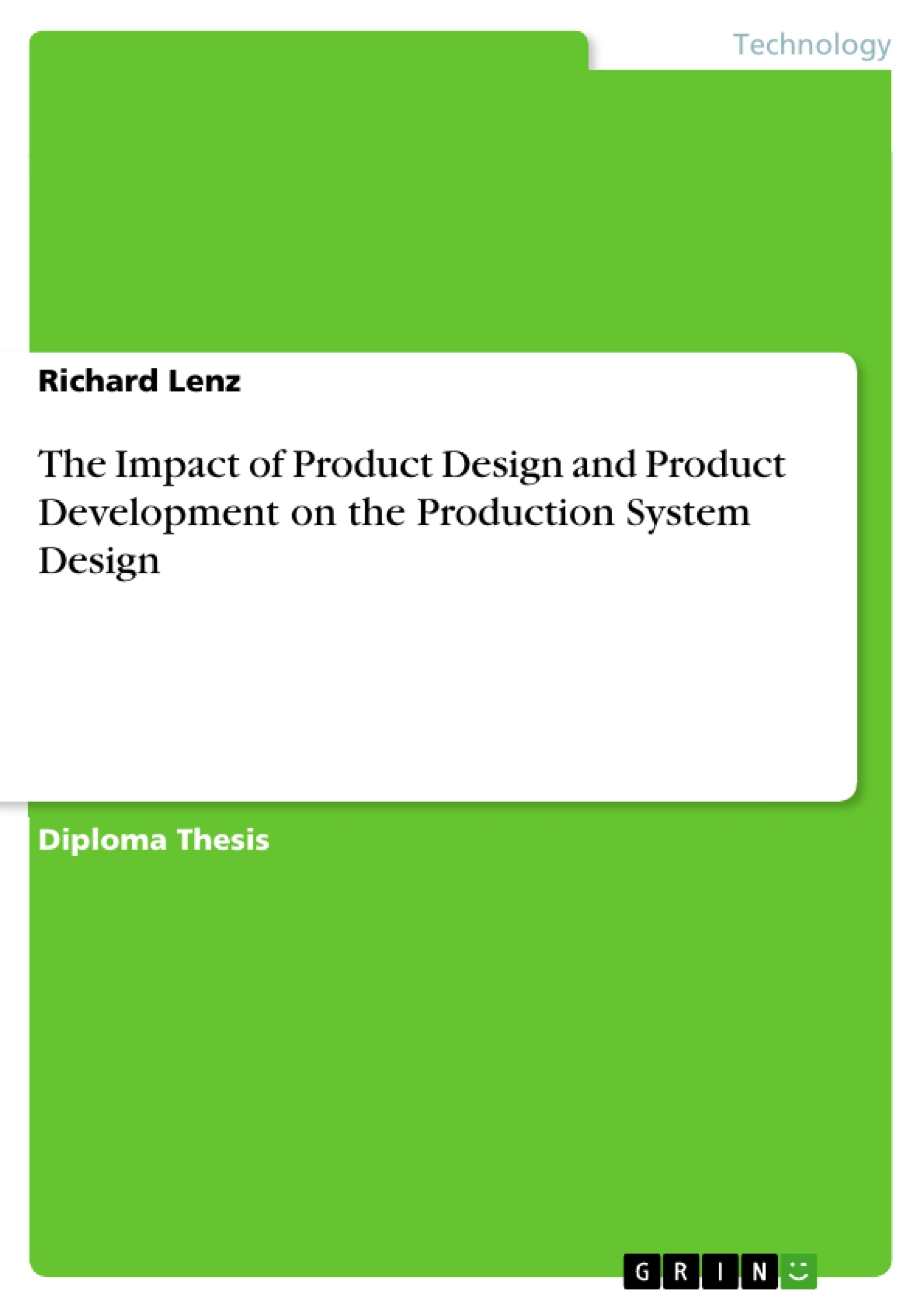The following thesis elucidates the impact of the product design and the product development process on the design of a manufacturing system. In contrast to integrate constraints and restrictions of the manufacturing system and its processes into the initial design of a product , attributes and characteristics of the product design are analyzed by the way they influence and restrict the design of a manufacturing system. The upcoming hypothesis of this thesis claims latter approach to be the natural and logical one.
A sophisticated design theory known as Axiomatic Design [Suh 1990] is used to embed the design of a manufacturing system into the design of the product and the product development system. The generic derivation of such an integrated design framework will allow a broad application to manufacturing and product development system design.
The following paragraph outlines the background and the issues related to the motivation for this thesis. In the next step, the thesis objectives and hypothesis are stated, marking the scope and content of this academic discussion. Finally, a brief overview is provided about the content and structure of each chapter.
Table of Contents
- ABSTRACT
- TABLE OF CONTENT
- INDEX OF FIGURES
- INDEX OF TABLES
- ABBREVIATIONS
- 1. INTRODUCTION
- 1.1 BACKGROUND AND MOTIVATION
- 1.2 THESIS OBJECTIVES
- 1.3 THESIS OUTLINE
- 2. THE PRODUCTION AND MANUFACTURING SYSTEM
- 2.1 AN INTRODUCTION TO SYSTEMS THEORY AND OBJECT-ORIENTATION
- 2.2 THE PRODUCTION SYSTEM
- 2.3 THE MANUFACTURING SYSTEM
- 2.3.1 DEFINITION OF A MANUFACTURING SYSTEM
- 2.3.2 THE ELEMENTS OF A MANUFACTURING SYSTEM
- 2.3.3 THE MANUFACTURING PROCESS
- 2.3.4 THE CHARACTERISTICS OF A MANUFACTURING SYSTEM
- 2.3.5 TYPES OF MANUFACTURING SYSTEM
- 2.3.6 THE DESIGN OF A MANUFACTURING SYSTEM
- 2.3.7 THE CONTROL OF MANUFACTURING SYSTEMS
- 2.4 LEAN PRODUCTION
- 2.4.1 THE TRANSITION OF THE MARKET REQUIREMENTS
- 2.4.2 THE PRINCIPLES OF THE TOYOTA PRODUCTION SYSTEM
- 2.4.2.1 The Objective
- 2.4.2.2 The Definition of Value and Waste
- 2.4.2.3 The Process
- 2.4.2.4 The Operation
- 2.4.2.5 The information flow
- 3. CHARACTERISTICS OF PRODUCT DEVELOPMENT
- 3.1 THE PRODUCT DEVELOPMENT PROCESS
- 3.1.1 PRODUCT DEVELOPMENT AS AN INFORMATION PROCESSING ACTIVITY
- 3.1.2 THE INTEGRATION OF PRODUCT DEVELOPMENT ACTIVITIES
- 3.1.2.2 Internal integration
- 3.1.2.3 External integration
- 3.1.2.4 The impact of integration on product development performance
- 3.1.3 THE DIFFERENT STEPS WITHIN PRODUCT DEVELOPMENT
- 3.2 THE DEGREE OF INTERNALIZATION VS. EXTERNALIZATION
- 3.3 DEFINING A PRODUCT DEVELOPMENT SYSTEM
- 3.3.1 THE DEFINITION OF A PRODUCT DEVELOPMENT SYSTEM
- 3.3.2 THE DESIGN OF A PRODUCT DEVELOPMENT SYSTEM
- 3.3.3 PRODUCT DEVELOPMENT AS A PART OF LEAN PRODUCTION
- 3.4 PRODUCT ARCHITECTURE AND PLATFORMS
- 3.4.1 PRODUCT DESIGN
- 3.4.2 IMPLICATIONS OF THE PRODUCT ARCHITECTURE
- 3.4.3 PRODUCT PLATFORMS
- 3.4.4 PART DESIGN
- 3.1 THE PRODUCT DEVELOPMENT PROCESS
- 4. CONCLUSIONS FOR INTEGRATING PRODUCT DESIGN AND PRODUCT DEVELOPMENT INTO THE DESIGN OF AN MANUFACTRING SYSTEMS
- 5. AN INTRODUCTION TO AXIOMATIC DESIGN TO DESIGN COMPLEX SYSTEMS
- 4.1 OBJECTIVE OF AXIOMATIC DESIGN
- 4.2 INTRODUCTION TO THE PRINCIPLES
- 4.2.1 THE DESIGN PROCESS AND DESIGN AXIOMS
- 4.2.1.1 The Independence Axiom
- 4.2.1.2 The Information Axiom
- 4.2.2 THE CONCEPTS OF DOMAINS
- 4.2.3 DECOMPOSITION AND HIERARCHY
- 4.2.1 THE DESIGN PROCESS AND DESIGN AXIOMS
- 4.3 AXIOMATIC DESIGN FOR SYSTEM DESIGN
- 5. A METHODOLOGY TO INTEGRATE THE STRATEGY
- 5.1 THE HIERARCHICAL MODEL OF STRATEGY
- 5.2 THE LINKAGE BETWEEN CORPORATE AND FUNCTIONAL STRATEGY
- 5.3 MANUFACTURING STRATEGY
- 5.3.1 DEFINITION
- 5.3.2 MANUFACTURING CAPABILITIES
- 5.3.3 MANUFACTURING DECISION AREAS
- 5.4 PRODUCT DEVELOPMENT STRATEGY
- 5.4.1 DEFINITION
- 5.4.2 PRODUCT DEVELOPMENT CAPABILITIES
- 5.4.3 PRODUCT DEVELOPMENT DECISION AREAS
- 5.5 STRATEGY INTEGRATION
- 6. SIMILARITIES AND INTERACTIONS BETWEEN PRODUCT DESIGN, PRODUCT DEVELOPMENT AND MANUFACTURING
- 6.1 SYSTEM SIMILARITIES BETWEEN MANUFACTURING AND PRODUCT DEVELOPMENT
- 6.2 LINKAGE BETWEEN PRODUCT DESIGN AND MANUFACTURING SYSTEM
- 6.2.1 PRODUCT DESIGN AND MANUFACTURING SYSTEM
Objectives and Key Themes
This diploma thesis explores the close relationship between product design and product development, analyzing how these processes can be effectively integrated into the design of a production system. It delves into the strategic and operational aspects of this integration, aiming to establish a methodology that harmonizes manufacturing and product development strategies, design, and control.- The strategic integration of manufacturing and product development
- The impact of product design on production system design
- The application of Axiomatic Design for system design and decomposition
- Lean Production principles and their influence on product development and manufacturing
- The use of performance measurement systems to control and optimize the integrated system
Chapter Summaries
Chapter 1 introduces the background and motivation for the thesis, outlining its objectives and structure. Chapter 2 delves into the concepts of production and manufacturing systems, exploring their elements, characteristics, design, and control. Chapter 3 focuses on the characteristics of product development, analyzing its process, integration strategies, and the concept of product architecture. Chapter 4 provides an introduction to Axiomatic Design, a powerful tool for designing complex systems. Chapter 5 presents a methodology for integrating manufacturing and product development strategies.
Keywords
This thesis centers on the integration of product design and product development into manufacturing systems, emphasizing the strategic alignment of manufacturing and product development strategies. Key concepts include Lean Production, Axiomatic Design, system design, decomposition, and performance measurement.- Quote paper
- Richard Lenz (Author), 1999, The Impact of Product Design and Product Development on the Production System Design, Munich, GRIN Verlag, https://www.grin.com/document/185322



